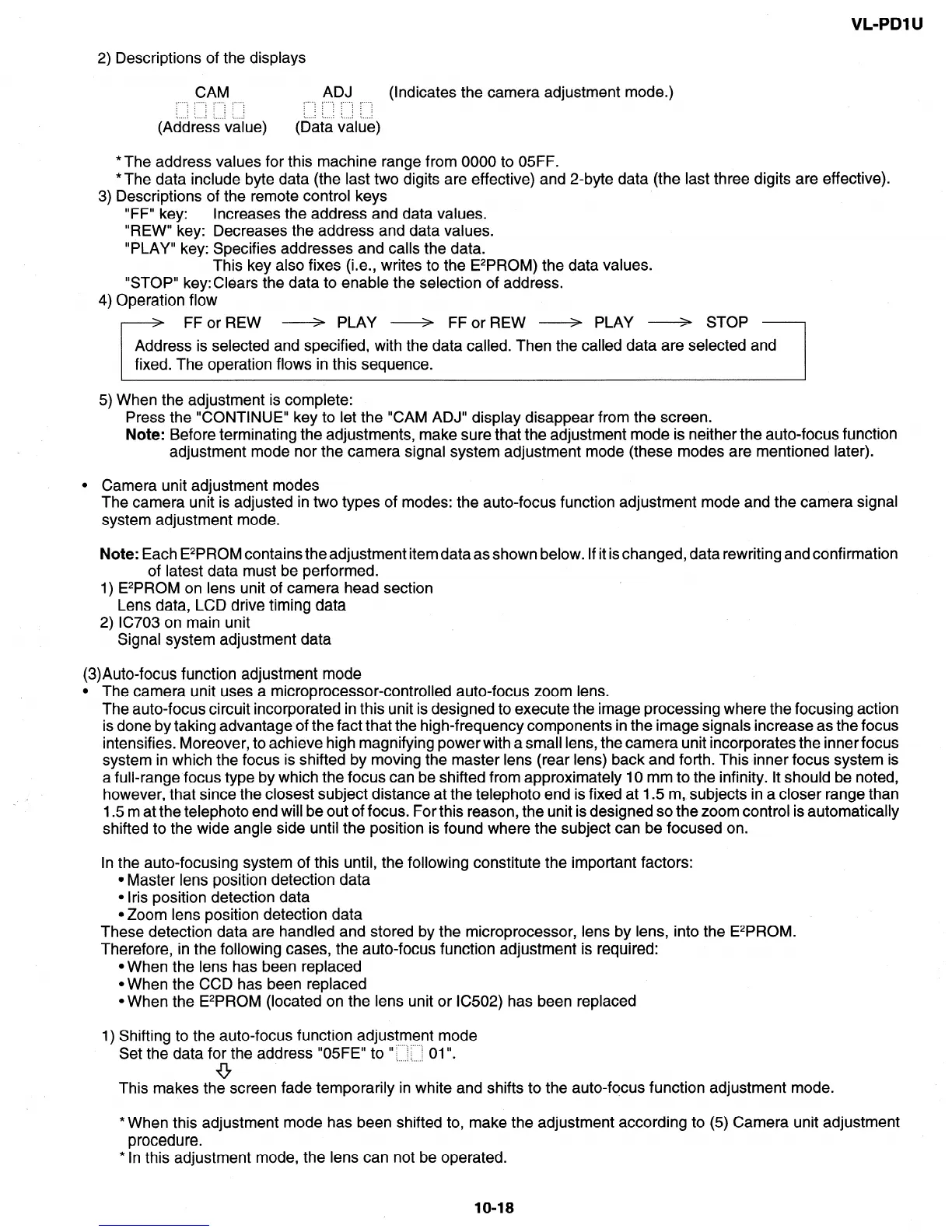VL-PDl U
2) Descriptions of the displays
CAM
ADJ (Indicates the camera adjustment mode.)
. . . . . . . . . . . . ., . . . . . . .
.....-.
. . . . . . . . . . . . . . . . . . .,
.-.....
: :: :: :::
: :: :: :::
: :: :: :::
: :: :::
::::i .
::.:: .
. . . . . . . . . . . . .
. . . . i . . . . . . i : ,....i
(Address value) (Data value)
*The address values for this machine range from 0000 to 05FF.
*The data include byte data (the last two digits are effective) and 2-byte data (the last three digits are effective).
3) Descriptions of the remote control keys
“FF” key:
Increases the address and data values.
“REW” key: Decreases the address and data values.
“PLAY” key: Specifies addresses and calls the data.
This key also fixes (i.e., writes to the E2PROM) the data values.
“STOP” key:Clears the data to enable the selection of address.
4) Operation flow
> FFor REW -----+ PLAY - FFor REW ------+ PLAY ---+ STOP
Address is selected and specified, with the data called. Then the called data are selected and
fixed. The operation flows in this sequence.
5) When the adjustment is complete:
Press the “CONTINUE” key to let the “CAM ADJ” display disappear from the screen.
Note: Before terminating the adjustments, make sure that the adjustment mode is neither the auto-focus function
adjustment mode nor the camera signal system adjustment mode (these modes are mentioned later).
Camera unit adjustment modes
The camera unit is adjusted in two types of modes: the auto-focus function adjustment mode and the camera signal
system adjustment mode.
Note: Each E2PROM contains the adjustment item data as shown below. If it is changed, data rewriting and confirmation
of latest data must be performed.
1) E2PROM on lens unit of camera head section
Lens data, LCD drive timing data
2) IC703 on main unit
Signal system adjustment data
_ ’
(3)Auto-focus function adjustment mode
l The camera unit uses a microprocessor-controlled auto-focus zoom lens.
The auto-focus circuit incorporated in this unit is designed to execute the image processing where the focusing action
is done by taking advantage of the fact that the high-frequency components in the image signals increase as the focus
intensifies. Moreover, to achieve high magnifying power with a small lens, the camera unit incorporates the inner focus
system in which the focus is shifted by moving the master lens (rear lens) back and forth. This inner focus system is
a full-range focus type by which the focus can be shifted from approximately 10 mm to the infinity. It should be noted,
however, that since the closest subject distance at the telephoto end is fixed at 1.5 m, subjects in a closer range than
1.5 m at the telephoto end will be out of focus. For this reason, the unit is designed so the zoom control is automatically
shifted to the wide angle side until the position is found where the subject can be focused on.
In the auto-focusing system of this until, the following constitute the important factors:
l Master lens position detection data
l Iris position detection data
.Zoom lens position detection data
These detection data are handled and stored by the microprocessor, lens by lens, into the E2PROM.
Therefore, in the following cases, the auto-focus function adjustment is required:
*When the lens has been replaced
@When the CCD has been replaced
*When the E2PROM (located on the lens unit or IC502) has been replaced
1) Shifting to the auto-focus function adjustment mode
Set the data for the address “05FE” to ” [.y:i[.y,< 01 ‘I.
9
This makes the screen fade temporarily in white and shifts to the auto-focus function adjustment mode.
*When this adjustment mode has been shifted to, make the adjustment according to (5) Camera unit adjustment
procedure.
* In this adjustment mode, the lens can not be operated.
lo-18
